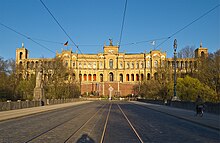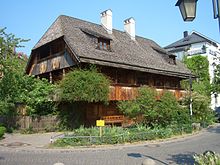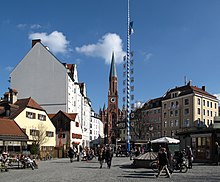Haidhausen
Haidhausen is a district of Munich . Today it is part of the city district 5 Au-Haidhausen .
Location and description



Haidhausen is located above the Au on the Isarhchterrasse. The district borders in the north on Bogenhausen , in the east on Berg am Laim , in the south on the Au, to the west the district closes off with the Isar .
The border of the district runs in the north along Prinzregentenstrasse , then west of Vogelweideplatz and between the recycling center and the tram depot to the railway line that forms the eastern border, whereby the entire railway body still belongs to Haidhausen. In the south, the Rosenheimerstrasse , Hochstrasse, Rablstrasse and Balanstrasse form the border with the Au. In the west, the right bank of the Isar is the limit.
The center of Haidhausen is Orleansplatz. The former village center was exactly at the intersection of Kirchenstrasse and Seeriederstrasse, where the Haidhauser district museum is located today . The oldest buildings in Haidhausen, four farms and a barn stood at the four corners of the intersection until the 17th century.
One of the three long-distance train stations in Munich is also located in Haidhausen, today's Munich East train station (formerly Munich Haidhausen). As a S-Bahn station and as a stop for other means of transport in the MVV, the station is called Ostbahnhof .
Haidhausen is home to the Maximilianeum, the seat of the Bavarian Parliament and the Gasteig , Munich's cultural center, which is also the seat of the Munich Adult Education Center , the Munich Philharmonic , the Munich City Library and the Music Academy .
history
Haidhausen was mentioned in a document in 808 under the name "haidhusir" (meaning: houses on the heath) as a settlement with a church. From Munich it can be reached via the "gaachen Steig" (roughly: "very steep path"), from which the term " Gasteig " became over time. The word also stands for the famous cultural center that marks the border to Haidhausen today. The Salzweg led through Haidhausen to Munich. The production of adobe bricks, which were made from the clayey soil, was economically important early on.
In the High Middle Ages Haidhausen belonged to the domain of the Counts of Wolfratshausen and after their extinction in 1157 the Counts of Dießen , who renamed themselves to von Andechs ; even before the death of the last Count Andechs, Otto III. In 1248 the area went to the Duchy of Baiern of the Wittelsbach family at the latest in 1246 . The district court of Wolfratshausen took the place of the count's intermediate authority . From 1610 or 1612, Haidhausen and the neighboring towns of Au and Untergiesing belonged to the court ob der Au . 1690 was Franz Pankratius of Leublfing to Rhain and Haidhausen in the imperial counts charged.
The country seat of the Counts of Preysing- Hohenaschau was located in Haidhausen from the 17th century to 1827 . Her castle later became the property of the church and the monastery buildings that still exist today were erected at the eastern end of Preysingstrasse in its place. On the other hand, not far from here (near today's Wiener Platz), small town-like structures with hostels for poorer sections of the population, who mainly worked in the brick factories that existed here, developed early on. The last of these houses can still be seen today, for example on Kreppe.
On the Isar high bank of Haidhausen, in the area of today's Gasteig, breweries used cellar vaults for a long time to cool their beer.
In 1835 there were already 10,000 people living in Haidhausen. Especially at the end of the 19th century, Haidhausen grew rapidly as a result of industrialization. At this time, the Klinikum rechts der Isar was founded here and the Maximilianeum was built as the end of Maximilianstrasse.
On October 1, 1854, Haidhausen was incorporated into the city of Munich together with Au and Giesing , after the residents of the localities had almost unanimously voted in favor of it in May 1848. The 1910 census showed that the Haidhausen area had a population of 61,555. After the defeat of the Munich Soviet Republic, on May 5, 1919, in the garden of the Hofbräukeller, previously denounced, innocent Perlach citizens were shot by members of the voluntary corps. In February 1919 the surgeon Ferdinand Sauerbruch and the painter Franz von Stuck were also detained by the revolutionary Red Guards in a school building in Haidhausen. On October 16, 1919, Adolf Hitler gave his first party-political speech to 111 visitors in the Hofbräukeller. On the day before the Hitler putsch on November 8, 1923, Hitler proclaimed the "National Revolution" in the Bürgerbräukeller on Rosenheimerstrasse.
In 1871, after two years of construction, the Haidhauser Bahnhof was opened, which was built by the architect of the Maximilianeum , Friedrich Bürklein . At that time, the “Auf den Lüften” area between the train station (east), Rosenheimer Strasse (south), Milchstrasse and Steinstrasse (west), Preysingstrasse (north) was still undeveloped. For the development of this area, Arnold von Zenetti designed an urban expansion plan in the style of the Wilhelminian era for the “streets to the Braunauer Bahnhof” in 1870 .
The semicircular Orleansplatz formed the basis for the symmetrically designed three-beam system of the Ostbahnhofviertel, which is also known as the "Franzosenviertel" because of its streets named after French places: Wörthstraße became the central axis - Weißenburger Straße and Belfortstraße the diagonals. The first streets were laid out in 1872 and named after locations of victorious battles in the Franco-Prussian War of 1870/71. One exception is Bordeauxplatz, which was later named due to the city partnership between Munich and Bordeaux. The area was built between 1870 and 1900, starting from Rosenheimer Straße in a northerly direction - predominantly in the neo-renaissance style of the 1880s and neo- baroque of the 1890s.
The development was tight in order to provide affordable housing for the poorer population. One of the most densely populated areas of Munich was created around 1900, and today it has a particularly high proportion (66%) of older buildings (before 1914).
For a long time, Haidhausen in Munich was considered a “broken glass district” due to its poor conditions. When industrial areas were demolished in the 1980s and replaced by living space, the municipal gallery Lothringer13 in Lothringerstr. 13, the Muffathalle and the Gasteig cultural center were built, the old buildings were also gradually renovated. The attractiveness of the quarter increased step by step, so that today Haidhausen is counted among a sought-after residential area in Munich, which is characterized by a multitude of shops, cafes, restaurants and a wide range of cultural activities.
Church building
- Catholic parish church St. Johann Baptist
- Catholic parish church St. Wolfgang
- Ev.-luth. Parish Church of St. John
- Catholic parish church St. Gabriel
- Catholic parish church Old Haidhauser Church
Cultural institutions
(Selection)
- Gasteig cultural center with concert halls, Munich Adult Education Center , Munich City Library , Munich Philharmonic and Munich University of Music and Theater
- Muffathalle
- Museum Villa Stuck
- Lothringer Art Gallery13
- Jazz club Unterfahrt
- Haidhausen Museum
Public institutions (selection)
Monuments and squares
Well-known citizens of Haidhausen
- Carlamaria Heim , actress and writer
- Erhard Dietl , children's book author
- Florian Henckel von Donnersmarck , director
- Georg Blüml , director and author
- Jan Gulbransson , artist, especially comics
- Michael Huber , manufacturer and mayor of Haidhausen
- Bruno Jonas , cabaret artist
- Robert von Langer , painter
- Erhard Paskuda , painter
- Willy Purucker , screenwriter, radio play director and radio presenter
- Max Reger , composer
- Joseph Schülein , Jewish brewery owner and philanthropist
nightlife
Due to its wide range of bars and restaurants, Haidhausen is considered a center of Munich's nightlife. In addition to inns and beer gardens, there are restaurants between Ostbahnhof, Rosenheimer Platz and Max-Weber-Platz restaurants for almost every regional cuisine.
literature
- Hermann Wilhelm : Haidhausen. Munich suburb over time . Buchendorfer Verlag, Munich, 1997, ISBN 3-927984-09-4 .
- Egon Johannes Greipl (ed.): Münchner Lebenswelten im Wandel - Au, Haidhausen and Giesing 1890–1914 . Volk Verlag, Munich 2008, ISBN 978-3-937200-51-4 .
- Walter Heerde: Haidhausen. History of a Munich suburb , Munich 1977 (Upper Bavarian Archive, Volume 98).
Web links
Footnotes
- ^ Ludwig Holzfurtner: Otto III .. In: New German Biography (NDB). Volume 19, Duncker & Humblot, Berlin 1999, ISBN 3-428-00200-8 , pp. 683 f. ( Digitized version ).
- ↑ Heinz Haftmann (2013): Das Dorf Obergiesing , p. 13.
- ↑ It is not possible to infer from the available evidence whether this survey of status was linked to direct imperial rule over Haidhausen or whether such rule had already been exercised by the barons of Leiblfing.
- ↑ [1]
- ↑ [2]
- ^ Wilhelm Volkert (ed.): Handbook of Bavarian offices, communities and courts 1799–1980 . CH Beck'sche Verlagsbuchhandlung, Munich 1983, ISBN 3-406-09669-7 , p. 601 .
- ^ Heinz Haftmann: The village of Obergiesing. 2013, p. 14.
- ↑ Friedrich Prinz, Marita Krauss (Ed.): Munich - City of Muses with backyards. The time of the Prince Regent 1886–1912. C. H. Beck, Munich 1988, p. 330.
- ^ Ferdinand Sauerbruch, Hans Rudolf Berndorff: That was my life. Kindler & Schiermeyer, Bad Wörishofen 1951; cited: Licensed edition for Bertelsmann Lesering, Gütersloh 1956, pp. 248–250.
Coordinates: 48 ° 8 ' N , 11 ° 36' E








